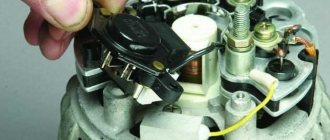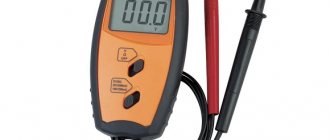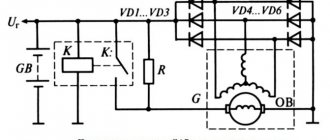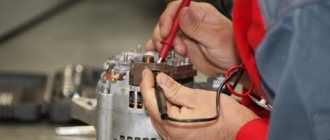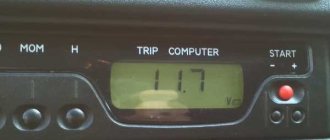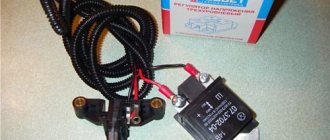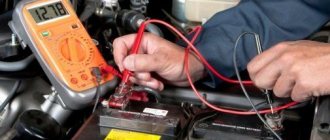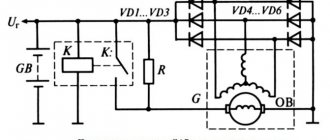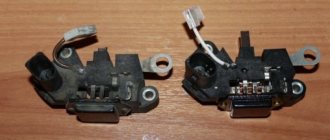The electrical equipment system has the main power sources, among which the generator is given a worthy place of honor. The voltage regulator of the VAZ 2114 generator is responsible for providing power to the on-board network for the functionality of all operating electrical appliances.
The device contains a rectifier unit that converts three-phase alternating current into direct current. Thanks to this device, surges in the output from the generator are reduced, and the voltage range should be from 13.2 to 14.7 Volts.
Where is the VAZ 2114 charging relay located? The unit is located at the rear of the generator, below under a plastic cover. The device is black and has two graphic conductive brushes.
Location of the voltage regulator on the VAZ 2114
Checking the functionality of the regulator
When diagnosing the generator voltage regulator, it is necessary to determine what breakdowns may be revealed during inspection (in order to avoid further malfunctions and effectively carry out preventive procedures).
Malfunctions while driving the car
- The light on the panel and other light sensors do not light up.
- The battery is low/overcharged and the regulator button is dark/bright.
The breakdowns can be as simple as a loose belt, a burnt-out relay, or worn out brushes.
To check the device you will need the following tools:
- sets of keys and screwdrivers;
- various testers;
- lamp 12 Volt 3 Watt;
- wires for connection;
- regulating current sources.
Checking the voltage regulator of the VAZ 2114 generator is carried out together with brush holders in order to immediately check the entire mechanism. You should carefully examine the condition of the brushes, their fragility, mobility, and length.
Check without removal. Using a voltmeter, we measure voltage readings. The optimal result is 13.5 - 14.2 V. If the data does not correspond to the norm, then there is a high probability of mechanism failure.
Before checking the voltage regulator and removing it from the car, you need to make sure that the fault lies in it and not in other components of the generator. How can I check this?
The first test option is diagnostics with the engine running using a voltmeter
What should be done? Start the engine and check the indicator light; if it does not go out and flashes brightly, it means there are problems in the generator. After a few minutes, when the engine increases speed and creates maximum conditions for the network load, we connect the meter and set 3500 rpm. Less than 13 Volts - the battery is completely discharged, when more - the regulator on the car needs to be replaced.
When you hear unusual noise from the unit, it means the bearings have failed, resulting in the drive belt being too tight. To adjust it, you need to turn off the ignition and release it. The deflection when pressed should not be less than two centimeters.
The second option is to check the mechanism on a stand
Before placing the electrical unit on the stand, you need to visually assess the condition of the brushes and slip rings of the commutator. Rings must be clean and dry. At the output, the current indicator gives at least 13 Volts, and the rotor speed is 6000 min-1. After 10 minutes of generator operation, the power output force can be measured. For a working unit, the indicators vary within 80 A.
If the indicator is less than normal, you need to look for faults in the starter windings or generator valves. If the indicators are not within the acceptable values, then we need to change the brush holder.
There are three valves with a red mark that provide a positive charge on the housing, they are located in the same plate of the rectifier block. Three more mechanisms have a negative charge, indicated by a black mark, connecting to ground.
Third option - check the serviceability of the winding and diodes
The multimeter shows the level of winding resistance; if there are malfunctions, there may be no indicators (break), or they will differ significantly from the norm - 4.5 Ohms. To fix the problem, the correct solution would be to replace or rewind the product.
To diagnose the relay-regulator, it is necessary to connect it to a regulating power source. This is a control lamp, the minus goes to the body of the electrical unit, and the plus goes to the terminal. The measuring device is turned on between the brushes, when the voltage increases to 17 Volts, the lamp should stop burning. When the opposite happens (the lamp burns brightly or dimly), then you need to change the voltage regulator.
You can ring the diodes with a tester; to do this, bring the probes of the device to the diode terminals. If a squeak occurs, then the probes should be changed, but when this sound does not stop, then there is definitely a breakdown of the diode. To eliminate it, the faulty unit or the entire unit is replaced.
When diagnosing the regulator, you need to inspect the electrical equipment protection capacitor. You can detect a fault with a megger. Visually inspect the fastening of the product. If there is no break, then the arrow of the device will first sharply deviate in the direction of decreasing voltage, and then return back again. The permissible capacitance of the capacitor is 2.2 µF ±20%.
How to verify that a regulator that is located far from the car is faulty. The 12V power source can be a car battery and 2 or 4 AA batteries connected in series, which will give a result of 16 V. If the lamp lights up during the test in both cases, and does not go out the second time of diagnosis, then a break has occurred and the unit needs to be replaced.
The fourth option is to check the removed regulator
Checking the VAZ 2114 voltage regulator
Above is a diagram of checking the voltage regulator after it has been removed. You need to connect exactly as indicated in the diagram. If everything is connected correctly and the lamp is on, then the regulator is working, and if the lamp remains extinguished, then it is faulty and requires replacement.
To get rid of on-board network voltage sags, you can use a three-level voltage regulator, which is used in many cars today, but that’s another article and new interesting information.
Despite the fact that the VAZ 2114 runs on gasoline, the electrical component in it is very important. Without maintaining the voltage within the required limits, the lighting will not be able to work, and the battery will be discharged. And most importantly, the ignition system will not be able to function without electricity, which means the engine will not work. Therefore, it is important that the electrical circuit of the machine is maintained in good condition.
Generator
The generator is designed to generate electricity, which is so necessary for the stable operation of the vehicle's electrical equipment. Additionally, it performs the function of recharging the battery - with a discharged battery it will be impossible to start the engine. For the VAZ 2114 model, the nominal voltage of the electrical circuit is considered to be 12 Volts, but taking into account all consumers (lighting, ignition system, instruments, stove motor, windshield wiper motor, etc.) it should always be higher. Therefore, the voltage in the electrical circuit can range from 13.2 to 14.7 Volts. To maintain it at the required value, a regulator is installed in the generator circuit. Moreover, this device is present in any car, and not just on the 2114 model.
Mounting block 2114-3722010-60
Circuit breakers
- Fuse for fog lights VAZ 2114, 2115 - rear fog light lamps and rear fog light indicator lamp
- Direction indicators
- Relay-breaker for direction indicators and hazard warning lights (in hazard warning mode)
- Hazard warning lamp
- Front interior lamp
- Central interior lamp
- Luggage compartment lamp
- Ignition switch illumination lamp
- Engine control lamp
- Brake lamps
- Trip computer (if installed)
- Portable lamp connection socket
- Rear window heating relay (contacts)
- Rear window heating element
- Sound signal
- Horn relay
- Cooling fan motor
- Fan fuse
- Electric windows
- Power window relay (contacts)
- Heater motor
- Heater fuse
- Windshield washer motor
- Electric motors for headlight cleaners (in operating mode)
- Cigarette lighter
- Glove compartment lamp
- Rear window heating relay (winding)
- Fuse for fog lamps VAZ 2114, 2115 - Right fog lamp
- Fuse for fog lamps VAZ 2114, 2115 - Left fog lamp
- Side light lamps on the left side
- Side light indicator lamp
- License plate lamps
- Engine compartment lamp
- Instrument lighting switch
- Fuse for backlight lamps of switches, instruments, cigarette lighter, ashtray, heater control levers
- Side light lamps on starboard side
- Left headlight (high beam). High beam indicator lamp
- Direction indicators
- Relay-breaker for direction indicators and hazard warning lights (in turn indication mode)
- Reversing lamps
- Lamp health monitoring relay
- On-board control system display unit
- Instrument cluster
- Low oil pressure warning lamp
- Parking brake indicator lamp (brake lights)
- Brake fluid level indicator lamp
- Low battery indicator lamp
- Trip computer (if installed)
- Generator field winding (in engine starting mode)
- Headlight wiper relay
- Relay-breaker for direction indicators and hazard warning lights
- Windshield wiper relay
- Relay for monitoring the health of brake lamps and side lights
- Power window relay
- Horn relay
- Heated rear window relay
- High beam relay
- Low beam relay
Source
Voltage regulator
It is not difficult to find where the VAZ 2114 generator relay is located. This device is located at the back of the generator itself under a plastic cover. Where is the charging relay located on the VAZ 2114 - a question for backfilling. The fact is that the charging relay, generator relay and voltage regulator on the VAZ 14th are generally one and the same single device. It is also called a relay regulator.
What happens if the voltage in an electrical circuit drops below 13.2 Volts? The battery will stop charging, and after a fairly short period of time the starter will no longer have enough power to crank the engine to start. What if it is over 14.7 Volts? Then elements of the electrical circuit may fail, for example, the radio or one of the engine sensors (mass air flow sensor, phase sensor, etc.) will burn out.
The charging relay on the VAZ 2114 looks like a large black tablet, at the end of which there are two graphite brushes (brush assembly). If there is little or no charging, the voltage regulator is checked.
Voltage regulator location
Diagnostics of the relay regulator
Checking the functionality of the generator on a VAZ 2114 always begins by measuring the voltage of the on-board circuit with the engine running. The most convenient way to measure is with a digital multimeter:
- We set up the multimeter to measure voltage and set the upper limit to 20 Volts;
- We connect the probes of the device to the battery and measure the voltage with the engine turned off. The voltmeter should show somewhere between 12.5 and 13 volts;
- We start the engine, the readings of the device with a good working generator should increase to about 14 Volts (maybe a little more);
- With the engine running, turn on the load (high beam, dimensions, heated rear window, heater motor at maximum speed). We look at the readings of the multimeter - the device should not show less than 13.2 Volts at idle, but it is better if this indicator is in the range of 13.8-13.9.
Checking the generator voltage regulator can also be carried out on a removed device. The device assembled with the brush assembly is checked. For this:
- We connect the mass terminal (minus) of the “tablet” with a wire to the minus of the battery.
- We supply power (12-14 Volts) to terminals “B” and “C” from the battery.
- We connect a 1-3 Watt car lamp to graphite brushes. If the relay-regulator is working properly, the lamp should light up.
There is another way to check the operation of the voltage regulator - when you need to check what the regulator's response threshold is at the upper limit. To do this, we increase the voltage in the circuit, for example, in parallel we add two or three 1.5 V AA batteries to the circuit. We need to increase the voltage to more than 16 volts, we connect everything else according to the same circuit. In this case, if the charging relay is working properly, the lamp should no longer light up.
Summarizing the results of both checks, we draw the following conclusions:
- If the lamp lights up during the first check, but does not light up during the second, then the voltage regulator is working;
- If the lamp lights up during both tests, the regulator has a breakdown;
- If it does not light up in either case, there is a break in the device between the brushes or contacts.
Replacement
The convenient location of the VAZ 2114 voltage regulator makes it quite easy to change without removing the generator itself.
We proceed as follows:
- Disconnect the battery terminals;
- We unscrew the nut by 10 with a wrench and move aside the positive wires going to the generator (red and black);
- We pull off the chip with a thin wire;
- Remove the rear plastic cover of the generator. It is attached to three clamps, and to remove it, the clamps must be bent;
- The relay regulator is mounted on two screws. Take a Phillips screwdriver and unscrew the screws;
- The “tablet” remains hanging on the wire. Carefully pull out the plug from the device and dismantle the regulator;
- We install the new part in the reverse order.
You can replace the relay regulator by removing the generator; here everyone chooses the method that will be most convenient.
We remove the generator from the VAZ 2114 ourselves
To diagnose a more serious malfunction of the VAZ 2114 generator, it is necessary to dismantle it. The device is held on a special bracket on the engine block. To remove the installation you will need the following tools:
- wrenches 10 and 13;
- open-end wrench 17x19;
- mount;
- head at 15.
You can dismantle the VAZ 2114 generator in different ways by removing the protection of the power unit, but we will tell you about the method of removing the device without touching the protection.
- Remove the terminals from the battery.
- Loosen the belt and remove it, and then remove the tensioning mechanism.
- Disconnect the wires from the generator, covered with a rubber boot, and also disconnect the voltage supply connector to the winding.
- The generator is held in place by a long bolt and nut. It is not easy to pull it out, so first unscrew the 15 bolts that hold the bracket on the block. They are located at the rear of the generator set. Rotate the charger clockwise, which will allow you to remove the axle attached to the bracket.
- Unscrew the nut with a size 19 wrench and pull it out with the bushing.
Using a punch or similar, knock the axle out of the bracket. Pull the generator up and you can start servicing.
Other reasons for not charging
If the battery is not charged or is insufficiently charged, in addition to a faulty voltage regulator, there may be other reasons related to the generator:
- The belt is poorly tensioned;
- Poor contact or break in the wires supplying power;
- Faulty rotor or stator winding;
- Poor contact of the brushes with the rotor commutator, the brushes are simply worn out.
The electrical equipment system has the main power sources, among which the generator is given a worthy place of honor. The voltage regulator of the VAZ 2114 generator is responsible for providing power to the on-board network for the functionality of all operating electrical appliances.
The device contains a rectifier unit that converts three-phase alternating current into direct current. Thanks to this device, surges in the output from the generator are reduced, and the voltage range should be from 13.2 to 14.7 Volts.
Where is the VAZ 2114 charging relay located? The unit is located at the rear of the generator, below under a plastic cover. The device is black and has two graphic conductive brushes.
Problems with the VAZ 2114 diode bridge
It is not difficult to check whether the diode bridge of the VAZ 2114 generator is working. Its breakdown may be indicated by a lack of charge and increased voltage produced by the generator. Both options can lead to unpleasant consequences for the electrical network and electrical equipment of the machine.
Failure of the diode bridge may be due to breakdown of power diodes, which can be replaced if you can find them. You can try to find the necessary spare parts from auto electricians, but it turns out to be much cheaper and easier to buy a new diode bridge and replace your old one with it. The work is carried out as follows:
- We install the contact bolt in the block and tighten it with nuts.
- We straighten and install the leads of the stator windings and tighten the nuts at the contact points.
- Tighten the bolts securing the rectifier unit.
- We install the brush assembly and tablet, screwing them to the back cover.
- We install the plastic protection and fasten the clamps.
After completing the work, we mount the VAZ 2114 generator in its place, connect the wires, tighten the belt and start the car.
Checking the functionality of the regulator
When diagnosing the generator voltage regulator, it is necessary to determine what breakdowns may be revealed during inspection (in order to avoid further malfunctions and effectively carry out preventive procedures).
Malfunctions while driving the car
- The light on the panel and other light sensors do not light up.
- The battery is low/overcharged and the regulator button is dark/bright.
The breakdowns can be as simple as a loose belt, a burnt-out relay, or worn out brushes.
To check the device you will need the following tools:
- sets of keys and screwdrivers;
- various testers;
- lamp 12 Volt 3 Watt;
- wires for connection;
- regulating current sources.
Checking the voltage regulator of the VAZ 2114 generator is carried out together with brush holders in order to immediately check the entire mechanism. You should carefully examine the condition of the brushes, their fragility, mobility, and length.
Check without removal. Using a voltmeter, we measure voltage readings. The optimal result is 13.5 - 14.2 V.
If the data does not correspond to the norm, then there is a high probability of mechanism failure.
Before checking the voltage regulator and removing it from the car, you need to make sure that the fault lies in it and not in other components of the generator. How can I check this?
The first test option is diagnostics with the engine running using a voltmeter
What should be done? Start the engine and check the indicator light; if it does not go out and flashes brightly, it means there are problems in the generator. After a few minutes, when the engine increases speed and creates maximum conditions for the network load, we connect the meter and set 3500 rpm. Less than 13 Volts - the battery is completely discharged, when more - the regulator on the car needs to be replaced.
When you hear unusual noise from the unit, it means the bearings have failed, resulting in the drive belt being too tight. To adjust it, you need to turn off the ignition and release it. The deflection when pressed should not be less than two centimeters.
Problems with the brush assembly of the VAZ 2114
The operation of the brush assembly depends on the brushes themselves and the electronic regulator, popularly called “chocolate” and “tablet”. Replacing the brushes of the VAZ 2114 generator can be done without dismantling the generator, but this is not very convenient.
To test the brush assembly you will need a regulated power supply and a 12 volt light bulb. Connect the power supply to the + and – of the regulator, and the light bulb to the brush - it should light up, and when the input voltage increases to 15 volts, it will go out. If it continues to burn at 16 volts, change the electronic regulator.
As for the VAZ 2114 brushes, their wear can be diagnosed by the following signs:
- lack of battery charge;
- low voltage on-board network;
- jumping charge voltage.
When free, the brushes should be more than 5mm long, and if yours is shorter, don’t hesitate to change them. To check the condition of the brushes, they must be moved in the grooves. They should move freely, and if they hang, lubricate them with a drop of oil.
Check the condition of the slip rings for wear. If present, sand the rings with the finest sandpaper. After replacing the brushes, if the problem was in them, the functionality of the generator will be restored immediately.
Causes of malfunction
In fact, there are several reasons why the battery lights up on the instrument panel of a VAZ 2114:
- fuse is blown;
- the diode bridge is faulty;
- gaps in the generator relay;
- tear in the generator belt;
- short circuit in wires;
- the generator itself;
- The fan belt may slip;
- There is not enough electrolyte in the battery.
As you can see, there are a lot of reasons and it’s quite difficult to figure it out right away, especially for an inexperienced driver. Most problems are related to the generator, but first you need to rule out other problems.
Specialists from any technical automotive center can very quickly reveal the “secret” of why the battery charging light does not go out, but this is an additional and sometimes considerable expense.
How to find a fault
First of all, you need to check the battery charging, as well as the ground (contacts). It may be a simple matter of oxidation of the wires or terminals. But in frequent cases, the battery light comes on precisely when the generator or its parts are faulty.
The car generator is designed to measure the mechanical rotational power in the crankshaft and convert it into electrical power. With its help, the battery device is charged, and all energy consumers in the car are “powered”: the diagnostic system, the ignition system, the panel (on-board) computer. Poor charging of the VAZ 2114 battery, in the overwhelming majority, is precisely a malfunction of the generator or its components.
There are few downsides to this: the battery is completely discharged and, as a result, you stop on the highway. I replaced the battery and moved on. But if the level of output power is greater than declared, then in this case the entire electrical system of the machine may fail. And then the cost of repairs increases significantly. But all this can be foreseen when the battery light is constantly on.
It is possible to replace the entire generator as a whole, but it will be cheaper to change some of its components. But before we get into that, we need to check the fuses and the unit itself. If a problem is found in it, then it must be replaced.
Generator check
You can't do this without the help of another person. We ask a friend to get behind the wheel, start the engine and use the gas pedal to raise the speed to 3000-3500. In this case, the high beam headlights, rear window defroster + heater must be turned on. We use a tester to check the battery and the supplied voltage, which should be around 13.2-13.6 volts. If the readings are lower, then the reason is a break or short circuit in the generator windings or their oxidation. If in this case you turn off the lights and other consumers, the voltage charge level should return to the values specified above. Also, the alternator belt may be loose, the diode bridge has oxidized, or the alternator brushes may be worn out. When replacing brushes, do not forget about their holders.
If oxidized wires or slip rings are to blame, then we clean or wipe with ordinary gasoline. We tighten a stretched belt, and replace a torn belt. Instead of faulty rectifier units and voltage regulator, we install new spare parts of the same brands and parameters. Increased noise during operation indicates wear of the generator bearing. It is cheaper to simply replace such a bearing. A faulty diode bridge is indicated by its melted components.
Mounting block 2114-3722010-18
Circuit breakers
- Headlight cleaners (when turned on)
- Headlight wiper relay (contacts)
- Headlight washer activation valve
- Turn Signals and Relays - Hazard Light Interrupter (in Hazard Mode)
- Hazard warning lamp
- Tail lights (brake lights)
- Interior lighting
- Rear window heating element
- Relay (contacts) for turning on the heated rear window
- Socket for portable lamp
- Cigarette lighter
- Engine cooling fan electric motor and its activation relay (contacts)
- Sound signal and relay for its activation
- Power windows for front doors
- Power window relay
- Headlight cleaners (in operating mode)
- Relay for turning on headlight cleaners (coil)
- Heater fan motor - heater fuse
- Window washer motor
- Rear window wiper motor
- Rear window washer timing relay
- Windshield and rear window washer activation valves
- Relay (winding) for turning on the electric fan of the engine cooling system
- Relay (coil) for turning on the rear window heating
- Rear window heating indicator lamp
- Glove compartment lamp
- Left fog lamp
- Right fog lamp
- License plate lights
- Engine compartment lamp
- Instrument lighting lamps
- External lighting indicator lamp
- Heater lever illumination display
- Cigarette lighter lamp
- Left headlight (side light)
- Left rear light (side light)
- Right headlight (side light)
- Right rear light (side light)
- Left headlight (high beam)
- Indicator lamp for high beam headlights
- Turn Signals and Relays - Turn Signal and Hazard Light Interrupter (in Turn Signal Mode)
- Turn signal indicator lamp
- Rear lights (reversing lights)
- Gearmotor and windshield wiper activation relay
- Generator field winding (when starting the engine)
- Brake fluid level warning lamp
- Oil pressure warning lamp
- Carburetor choke warning lamp
- Parking brake warning lamp
- Signal lamp "STOP"
- Coolant temperature gauge
- Fuel level indicator with reserve warning lamp
- Voltmeter
- Headlight wiper relay
- Relay-breaker for direction indicators and hazard warning lights
- Windshield wiper relay
- Lamp health monitoring relay
- Power window relay
- Horn relay
- Heated rear window relay
- High beam relay
- Low beam relay
Unsustainable breakdown - hurry up with repairs!
It would seem that there is something wrong here - there is not enough tension. The car runs on gasoline, not electricity. However, a lack of current power leads to an increase in fuel consumption, a decrease in engine power, and some electrical appliances stop working altogether and will require replacement in the future. This is especially noticeable in the dark, when many power supply devices are used.
The first sign of lack of voltage is dim high beams - their lamps require a large number of watts. In most cases, it turns out that the battery is poorly charged.
You can deal with this problem easily and quickly by charging it properly. However, sometimes this doesn't help. Look under the hood - the battery terminals may be loose or oxidized. If in a parking lot the current still maintains a constant voltage, then during driving, due to vibration, the terminals may move away, opening the circuit. To fix the problem, you need to thoroughly lubricate the fasteners and tighten the bolts; sometimes only replacing the old terminals with new ones will help.
Generator failure - how to determine?
A breakdown of the generator entails big troubles - electrical appliances may fail and the battery life will be reduced. So, if the voltage regulator relay fails, the generator may produce a voltage greater than required. This can cause problems in the correct readings of electrical appliances, as well as in the operation of the car's lighting.
To independently check the functionality of the generator, you will need a tester and an assistant. First of all, insert the key into the ignition and start the car. The battery light on the dashboard should illuminate to indicate a low charge or an open circuit. It is necessary to warm up the car to operating temperature and turn on all possible devices in it.
Then take a tester and check the voltage at the battery terminals. During this time, your partner should keep their foot on the gas pedal and maintain 3000–3500 rpm of the engine. The voltage on the tester in a VAZ 2114 car with a normal working generator should be at least 12–13 Volts. If the voltage is less, it is necessary to proceed with a detailed check of the device. Urgent repairs are also required if the current is greater than 14.7 Volts. This applies not only to the VAZ 2114, but also to other passenger cars.
When checking the operation of the generator, you need to listen to its sound. The presence of a characteristic hum or noise from belt friction indicates wear of its bearing, in which case a complete repair of the device is necessary. Also, quite often the ground contact on the car’s generator turns out to be poor, because the wire is located quite low in the VAZ 2114. During rainy weather, water gets on it, which causes oxidation of the contact terminal.
Another reason for low voltage may be a tight or sufficiently worn alternator belt. As a result, the generator may not turn the required number of revolutions to maintain normal power supply. In this case, it is necessary to tighten it or replace it. The work of tightening or replacing the alternator belt will not take much of your time, and also does not require specific technical skills.
How to check the ignition relay?
There are several ways to make sure that the relay has burned out. You can do this on your own. Sometimes it is enough to remove it and see the melted or broken parts. It may crack or develop other visible defects.
After a long drive, the transmission can become very hot. This indicates its malfunction or low power.
The main relay for this model is designed for a current of 70 Amps. But perhaps the part has less power or there are many additionally installed consumers on the car. You can check this by disconnecting several of the devices.
If after this the element stops heating, then its power is too low. It is necessary to buy a part of a similar design, but designed for a higher current.
You can check the functionality of the ignition relay with a multimeter. To do this, set it to voltmeter mode. They need to measure the voltage on the starter winding and the output of this part. If voltage is present, the element is working.
You can test the part with a multimeter in ohmmeter mode. Measurements are carried out in a similar way. The value on the device screen is completely unimportant. The presence of any indications indicates the serviceability of the relay. If there is no indication, it needs to be replaced.
You only need to buy a similar element designed for this car model. Defective products are often found on sale. Therefore, if after installing a new relay the problem does not disappear, you should check this part again. All the previously mentioned methods are suitable for this. In the case discussed above, it is necessary to purchase an electrical component of slightly higher power. Most likely it will be from another car. Therefore, for selection you need to take the old relay with you. If, after replacing the element and if it is known to be in good working order, problems with starting the engine or the heater persist, you should look for another reason. It is a good idea to test all the wiring of the machine. It could rot or fray over time. Other parts of the car may also be to blame for the malfunction. If self-diagnosis of electrical equipment is difficult, you need to contact an electrician at a car service center.
Source
The voltage regulator is the basis of the generator
The voltage regulator is located in the car's generator and is responsible for distributing voltage from the generator to the car. This part consists of an armature, an electromagnet and a switch. If it fails, a complete replacement is necessary.
To remove the voltage regulator, you need a few standard wrenches and screwdrivers. You can remove this element in a VAZ car without dismantling the generator. Do not forget to remove the terminals from the battery before starting work. Next, unscrew the contact terminals on the generator - they are located under the cap. After this, remove the protective cover, this must be done carefully so as not to break the spring latches that secure it to the generator.
Then unscrew the fastenings of the voltage regulator and pull it out along with the brushes. Checking the voltage regulator should only be done with brushes. The length of normal working brushes should be at least 4–6 mm. To test the functionality of the voltage regulator at home, we will need a battery, several contact wires and a 12-volt lamp.
The light bulb must be connected to the generator brushes, and the polarity does not matter. Connect the negative contact of the battery to the regulator body, and the positive contact to the power contacts on the regulator. If all elements are properly connected and working, the light should light up. If this does not happen, then the voltage regulator needs to be replaced. There is another way out - give the regulator to an experienced electrician to check, perhaps he will fix the breakdown.
Replacing the voltage regulator in a VAZ 2114 car is a fairly simple procedure. The voltage regulator for the VAZ 2114 can be bought at any auto store, but it will not work with other VAZ models. Car owners have recently replaced the standard regulator with a three-level one. It is better to entrust its installation to an experienced specialist, since it requires minor changes to the generator housing, as well as correct reconnection of the contact terminals to the relay.
The three-level voltage regulator contains an improved relay. It makes the voltage more stable and of higher quality. However, at the VAZ 2114 plant this regulator has not yet begun to be put into mass production for cars. After completing all repair work, reassemble and connect everything in reverse order. It is recommended to charge the battery during repairs.
